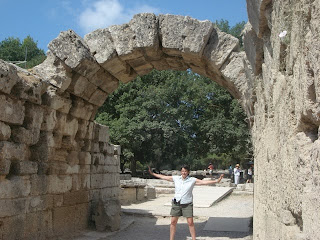
This morning, refreshed and renewed, we took on the city of Athens ready to walk in the footsteps that Athenians have traveled for three millennia.
Our first stop was the Acropolis, “high city”, which rises above the modern city of Athens, a true testament of the Golden Age of Athens in the fifth century B.C. The
Acropolis is the highest point of the city, which was used for religious purposes, recreation, and pleasure. Since Neolithic times, the Acropolis has been used for these multi-purposes. Some of the great “textbook” iconic ima
ges of Greece were seen today, from the Parthenon to the world’s first theater of Dionysus. On our approach to the Parthenon, we learned about and viewed the Erechtheion, with its Porch of the Caryatids lined with stone ladies. These statues, not only served as great works of art, but also were a po
litical statement. Since only slaves carried goods on their heads, the Athenians created these Caryatids to depict the lower social standing of the Spartans. Although the Caryatids are replicas on the site, we later were able to view the remains of the original Caryatids at the NEW Acropolis Museum. (Keep reading for more details on th
e museum later in this blog.)
The road to the top of the Acropolis was covered by large slabs of the original marble, worn smooth and slippery by millions of pairs of feet over time. It was explained to us that marble is the most abundant buil
ding resource in the country – even cheaper than timber – and is used in construction in place of wood whenever possible (which explains our marble bathrooms and marble streets and sidewalks in the Plaka). Once atop the “high city”, our local guide, Katya, gave us the Cliff’s Notes version of the history of the Parthenon – the various conquests by the Persians, Turks, and Christians (all of whom laid siege to the city and made artistic and political changes to the Parthenon. The Parthenon is once again under siege, this time by good intentions, as the nation’s premier symbol is being restored by newly quarried marble to reinforce the columns that have fallen victim to Greece’s frequent seismic activity.
Descending the south side of the Acropolis we saw Dionysus’s Theater, which is the oldest theater in Europe. Over 15,000 people attended the performances of the famous Greek tragedies of So
phocles and Euripedes. Special front row marble seats were built into the theater for dignitaries and persons of high status.

The next stop was the new Ac
ropolis Museum which was finally completed in 2009. The museum was constructed with the collaboration of archeologists, scientists, artists, and psychologists in order to ensure that the museum served its purpose of fitting into the culture, history, beliefs and practices of the Greek peoples. Although many of the original artifacts and statues are currently in the British Museum, places are held in the museum for their hopeful return to Athens. Some Athenians claim that the statues that remain in the museum cried when the others were taken from their places. The hope lives on that the statues will again cry (this time with tears of joy) when the others are returned to Greece.

After lunch, our final “official” stop of the day was the National Archaeological Museum. We walked through the history of Greek statuary, from the simple Greek Archaic figures, which were inf
luenced by earlier Egyptian art, to the breathtakingly beautiful creations of Classical Greece artists. Amazingly, most of the statuary art was not behind gl

ass or even ropes. We were able to come face to face with the visages of Athena, Aphrodite, and other Olympians and were able to photograph many of them.
The tour at the National Archaeological Museum ended with our visit to the artifacts unearthed in 1874 in Mycenae by Heinrich Schliemann, a self-made millionaire who amassed his wealth solely to fund his archeological fanaticism. The dazzling array of 16th Century BC treasures included the famous Mask of Agamemnon, gold jewelry and cups, intricately designed pottery vessels, weapons, and figurines to name a few.
After a quick dip in the pool, we returned to the plaka for a traditional Greek Taverna (aka restaurant) dinner of spinach pie, Greek salad, shish kabobs, and delicious ice cream of an unidentified flavor.
We now will retire to bed, as we have a 5:30 a.m. wake up call in the morning…
Kalinichta!
 We started the day in Nafpilo, climbing the 999 stairs to Fort Palamidi which dominates the skyline of this town. The views are spectacular.
We started the day in Nafpilo, climbing the 999 stairs to Fort Palamidi which dominates the skyline of this town. The views are spectacular. A temple to Apollo dominates the remains of this once great city. The other highlights included a Roman shopping mall, complete with decorative fountains, store stalls, a marble-paved street, and a public restroom.
A temple to Apollo dominates the remains of this once great city. The other highlights included a Roman shopping mall, complete with decorative fountains, store stalls, a marble-paved street, and a public restroom.





















